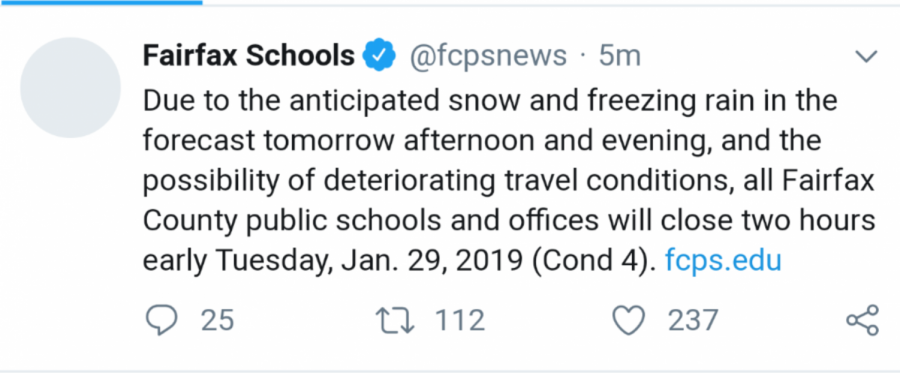Delays vs. Early Releases: Two Hours Mean Everything
Tuesday, Jan. 29 was the first early release of the 2018-2019 school year for Fairfax County.
January 30, 2019
Tuesday, Jan. 29 marked the first two-hour early release Fairfax County called in the 2018-2019 school year, due to an inclement weather forecast for early that afternoon. So far, FCPS has also called five two-hour delays. All these closures meant shortened classes and more time to either get work done at home or sleep, but they opened up time at opposite parts of the day, which could’ve made a big difference to students at Jefferson, where every minute is precious. Overall, two-hour delays provide more effective extra time for students than two-hour early releases.
At Jefferson, two-hour delays mean more than shortened classes depending on whether they fall on red days or anchor days. On red days, one block of eighth period is cut by administration, and JLC is cut on anchor days. Jefferson students normally use these blocks of time to relax or get work done, and when this time is taken away, their plans for the rest of the week may be completely altered. Similarly, the same amount of time is cut from the school day by taking away eighth periods and JLC during a two-hour early release. Therefore, two-hour delays and two-hour early releases deliver the same blow to students’ schedules.
While the two may seem the same in terms of the school day itself, they are certainly not in terms of transportation. Other counties sending students to Jefferson do not always experience the same inclement weather conditions as Fairfax County. As a result, they sometimes make different calls regarding school closings, delays, and early releases. Counties that provide transportation for their Jefferson students run on their county’s schedule, so if the calls are not the same, Jefferson students are not provided transportation for that day. In the case of a two-hour delay, parents and students have time to make carpool arrangements either late the night before or the morning of. This is all dependent on when each county makes their call. Since two-hour early releases are mostly called the evening before inclement weather is expected or when the inclement weather is worse than expected during the school day, planning for transportation is either really easy or difficult. There is either an abundance of time to make alternative arrangements or no time at all.
While two-hour early releases result in the same shortening of classes, an early release allows students more time to do their nightly homework. A student with three hours of homework that normally gets home at 6:00 pm can finish their homework by 7:00 pm instead of 9:00 pm. This gives students more free time and an opportunity for extra sleep. However, some students decide to take their extra free time before starting their homework and end up finishing at the same hour they would without a two-hour early release. This only allows for the same amount of sleep as a normal day. Students have to get to school at the same time in the morning, which means that most of them will experience the same feelings of tiredness. On the other hand, since two-hour delays allow students to sleep in for two hours, should they choose to do so, they are refreshed and fully awake when arriving at school.
No one can control the weather. That does not change the fact that two-hour delays are more beneficial than two-hour early releases. Neither of those two options provide the same positive thrill that full cancellation does, but they provide extra time for students to do what they want or need. Whether there be a two-hour delay or a two-hour early release, it is always important to not only travel cautiously during that time but also spend the extra time wisely.






